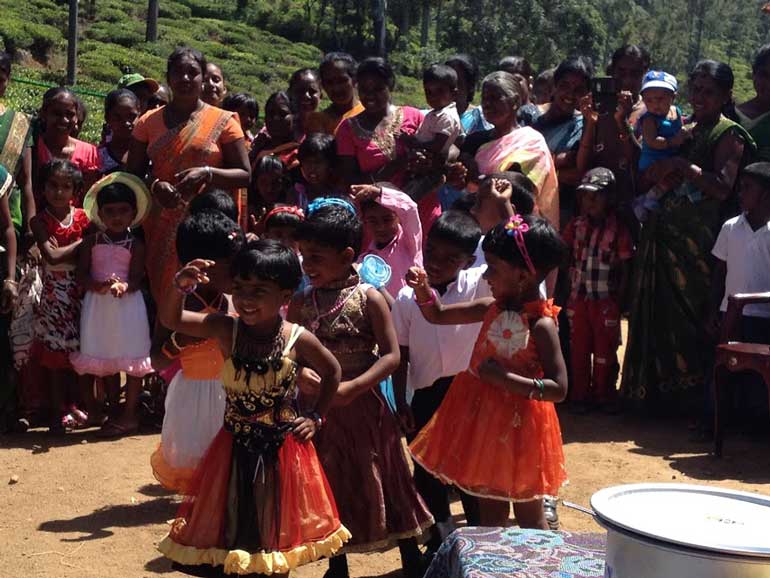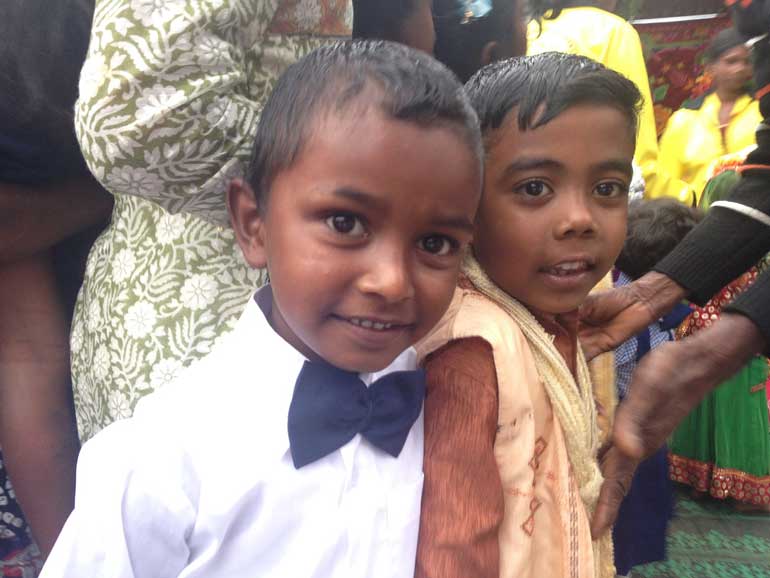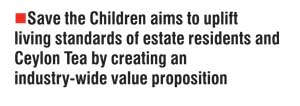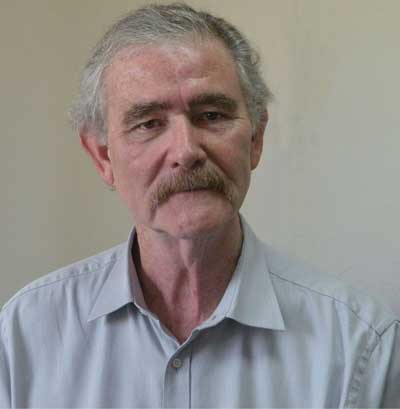Wednesday Feb 12, 2025
Wednesday Feb 12, 2025
Saturday, 19 December 2015 00:00 - - {{hitsCtrl.values.hits}}

Beneficiaries of the project

 In a reinvigorating development for the local tea industry, Save the Children Sri Lanka has put forward a unique proposal which has the potential to remarkably improve the lives of Sri Lanka’s estate community, while rejuvenating the Ceylon Tea brand by creating an industry-wide value proposition.
In a reinvigorating development for the local tea industry, Save the Children Sri Lanka has put forward a unique proposal which has the potential to remarkably improve the lives of Sri Lanka’s estate community, while rejuvenating the Ceylon Tea brand by creating an industry-wide value proposition.
The proposed project represents a potential global first by seeking to drastically re-align the manner in which Corporate Social Responsibility (CSR) is practised by an entire industry. In essence, it seeks to bring together all stakeholders to enhance the lives of the estate community, particularly through maternal and child health and nutrition and early childhood development, communicate these developments compellingly to buyers and thereby re-position Ceylon Tea to earn a premium.
The initiative seeks to combine both the superior product attributes with regard to Ceylon Tea and emotional appeal to promote Ceylon Tea as ‘the finest, most expensive tea; grown with the greatest possible care taken to the families who bring it to you, and the land on which it is grown.’ 
Several influential industry stakeholders including the Planters’ Association of Ceylon which represents the Regional Plantation Companies (RPCs), the Plantation Human Development Trust (PHDT), the Sri Lanka Tea Board, the Ministry of Upcountry New Villages, Estate Infrastructure and Community Development and the Ministry of Plantation Industries have expressed keen interest in working with Save the Children on the project. The pilot phase is already underway at 14 tea estates managed by Regional Plantation Companies.
Among the works being completed in 2015 under the pilot phase are: the construction of 1,281 new latrines, repairing of 282 latrines, the construction, rebuilding and resupplying of 20 Early Childhood Care and Development (ECCD) centres, the rebuilding of six medical facilities, the construction of eight new water supply schemes and the distribution of 25,000 items of material on early childhood development in Tamil.
“When we look at the living conditions of the people living in Sri Lankan tea estates, especially the conditions relating to mothers and young children, it is clear that while things have improved remarkably since privatisation in 1992, there is still a substantial way to go,” Save the Children Sri Lanka Director and the project’s mastermind, Will Lynch said, explaining the rationale for the project. “Despite the best efforts of many stakeholders including the RPCs, the PHDT and the government, we have identified a number of issues including chronic anaemia and stunting among children and uneven access to water and sanitation facilities in tea estates. We strongly believe that the creation of an industry-wide value proposition can solve these issues in a sustainable manner while also revitalising Ceylon Tea globally, especially in high-income markets with low penetration at present.”
The program was envisaged following extensive research conducted on Ceylon Tea, association between Sri Lanka and Ceylon Tea and the importance of the welfare of worker families to tea buyers.
The research was conducted among eight countries – US, UK, Canada, France, Germany, Japan, Australia and South Africa – and generated over 5,500 completed surveys. It found that largely Ceylon Tea and the Lion logo was not well-known, not identified as being Sri Lankan and that tea drinkers are interested in a value proposition relating to premium quality and relating to health of mothers (pluckers) and children. After identifying the good potential for a premium quality and ethical single origin tea brand, the framework for the proposed project was formulated.
“Large amounts of funds are committed for the improvement of living standards of the estate community by the government, multilateral institutions, donor agencies, the PHDT and the Regional Plantation Companies,” Lynch noted. “The issue is often the ad-hoc nature of the programs and lack of coordination between these efforts. The government has the ability to coordinate all these funds to a programme to uplift the community while creating a value proposition for Ceylon Tea.”
Save the Children alone has committed $ 1.4 million in 2015 for the improvement of child and maternal health and nutrition in Sri Lankan tea estates and expects to commit a further $ 4.5 million over the next three years. In addition, funding which has already been committed or is in the pipeline from all stakeholders such as the World Bank, European Union and INGOs (even excluding the government) for all development projects in Sri Lankan tea estates amount to a vast $ 100 million, Lynch points out. Rather than allowing these funds to be invested in isolation, the Government has an opportunity to facilitate them to be invested in manner which creates a value proposition for Ceylon Tea, which would benefit the workers and their families through increased incomes.
In implementing the project, to directly link the welfare of women and children in tea estates to Ceylon Tea, Save the Children suggests realigning the requirements to obtain the certification given by the Sri Lanka Tea Board for pure Ceylon Tea (displaying the lion logo). Accordingly, criteria/standards with regard to the wellbeing of mothers and children in tea plantations can be included in addition to the present requirements to obtain Ceylon Tea certification. Subscribers to this standard will receive assistance in meeting the required targets.
“We believe that this highly commendable initiative by Save the Children is most timely and can benefit the entire local tea industry,” Planters’ Association Chairman Roshan Rajadurai said, commenting on the proposed project. “The Regional Plantation Companies have always strived to improve the lives of our workers despite financial constraints and are therefore most willing to extend our support to this project and urge other stakeholders to do so as well.”
Discover Kapruka, the leading online shopping platform in Sri Lanka, where you can conveniently send Gifts and Flowers to your loved ones for any event including Valentine ’s Day. Explore a wide range of popular Shopping Categories on Kapruka, including Toys, Groceries, Electronics, Birthday Cakes, Fruits, Chocolates, Flower Bouquets, Clothing, Watches, Lingerie, Gift Sets and Jewellery. Also if you’re interested in selling with Kapruka, Partner Central by Kapruka is the best solution to start with. Moreover, through Kapruka Global Shop, you can also enjoy the convenience of purchasing products from renowned platforms like Amazon and eBay and have them delivered to Sri Lanka.
Discover Kapruka, the leading online shopping platform in Sri Lanka, where you can conveniently send Gifts and Flowers to your loved ones for any event including Valentine ’s Day. Explore a wide range of popular Shopping Categories on Kapruka, including Toys, Groceries, Electronics, Birthday Cakes, Fruits, Chocolates, Flower Bouquets, Clothing, Watches, Lingerie, Gift Sets and Jewellery. Also if you’re interested in selling with Kapruka, Partner Central by Kapruka is the best solution to start with. Moreover, through Kapruka Global Shop, you can also enjoy the convenience of purchasing products from renowned platforms like Amazon and eBay and have them delivered to Sri Lanka.